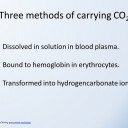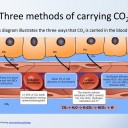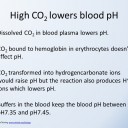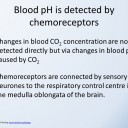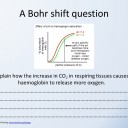Carbon dioxide and Bohr shift
These lesson activities give students an understanding of the different methods of transporting carbon dioxide in the blood, the role of hemoglobin, the enzyme carbonic anhydrase and the Bohr shift. A set of slides introduce the key concepts and these are followed by some questions and model answers. Most (70%) of the CO2 in blood is transported as bicarbonate ions (HCO3-), while 23% is carried in the form of carbamino-hemoglobin. A small fraction (7%) is actually dissolved in blood.
Lesson Description
Guiding Questions
- How many ways can you think of that carbon dioxide could exist in a solution?
- What does CO2 do to the pH of a solution?
- Which part of the brain controls pulse rate? Could this part also control breathing rate?
Activity 1 - Carbon dioxide transport in the blood
Look at the slides about the three methods of carbon dioxide transport in the blood:
- in solution
- bound to hemoglobin
- transformed in red blood cells into hydrogencarbonate ions which diffuse into the blood plasma.
Answer the questions from the slides on this ![]() Questions about transport of carbon dioxide worksheet.
Questions about transport of carbon dioxide worksheet.
The percentage of carbon dioxide transport by each method
CO2 is readily soluble in water but less than 10% of CO2 carried dissolved in blood plasma lowering blood pH.
About 20% of the CO2 reacts with the amino (-NH2) groups on hemoglobin molecules to form carbamino compounds such as carbaminohemoglobin.
Most CO2 (70%) is transported in blood as bicarbonate ions (HCO3-)
Activity 2 - Respiratory centre of the Medulla oblongata
Imagine you have carried out an experiment to measure your blood oxygen concentration at different altitudes on a mountain. You have ten volunteers and they are each tested at six different altitudes. The results in the table below were obtained in this experiment using an oximeter like the one shown in the photo below.
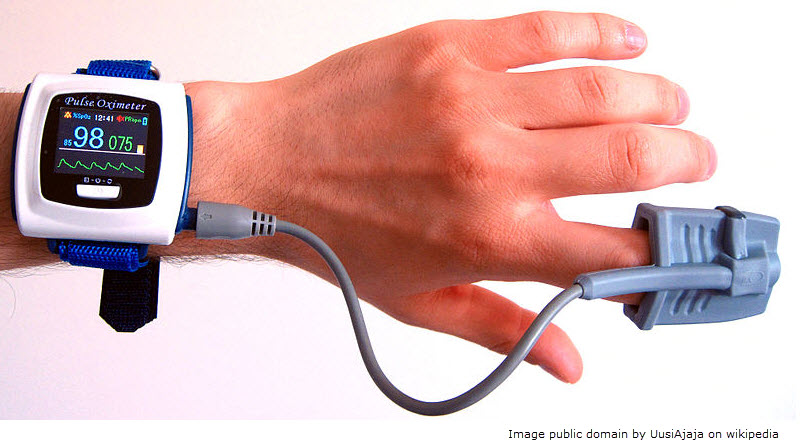
Physiological values & blood Oxygen concentration in Sherpas at different altitudes
| A: Pheriche (4,243 m) | B: Namche (3,440 m) | C: Pakding (2,650 m) | D: Kathmandu (1,330 m) | Sea Level Group | |
|---|---|---|---|---|---|
| Number of subjects | 10 | 10 | 10 | 10 | 10 |
| Age, yr (+/- 1SD) | 32 ±10 | 24 ±6 | 30 ±7 | 26 ±6 | 36 ±10 |
| Weight, kg (+/- 1SD) | 64 ±6 | 60 ±10 | 61 ±8 | 51 ±8 | 75 ±18 |
| Sex, male/female | 8/2 | 5/5 | 6/4 | 3/7 | 4/6 |
| Arterial oxygen saturation, % (+/- 1SD) | 88 ±3 | 93 ±2 | 96 ±1 | 97 ±2 | 97 ±2 |
| Partial pressure of CO2 in exhaled air, kPa (+/- 1SD) | 4.1 ±0.3 | 4.3 ±0.3 | 4.4 ±0.4 | 4.3 ±0.4 | 4.9 ±0.4 |
Data from: Role of the altitude level on cerebral autoregulation in residents at high altitude,
Answer the questions about this data on the worksheet ![]() Altitude and CO2 transport - IB style questions
Altitude and CO2 transport - IB style questions
Activity 3 - The Bohr Shift
Deoxygenated hemoglobin (deoxy-hemoglobin) has a high affinity for H+ attaching to H+ ions allows deoxygenated blood to carry more CO2 than oxygenated blood with mostly oxy-hemoglobin. Any H+ not bound to deoxy-haemoglobin will lower the pH of blood, from pH7.4 to pH7.2. At lower pH the oxygen affinity of hemoglobin is lowered causing more oxyhemoglobin to become deoxyhemoglobin. The combination of these three effects allows deoxygenated blood to carry more CO2.
Draw a flow diagram showing these three effects and the resulting ability of CO2 to carry CO2
Teacher's notes
The chemistry in this topic could be quite tricky and quantitative. The chemical details have been kept to a biologically acceptable minimum in this activity,but chemists may wish to take these points further.
The slides in Activity one can be used by the teacher at the start of the lesson or they could be made available to students as reference while they attempt the questions. The short questions in activity 1 are really not very complex.
Activity uses some real research data from Nepal as the background for some IB style data analysis questions. There are some model answers for these questions.
The last activity is really extension work. Can students create a simple flow diagram to explain the interactions of pH and the saturation of oxygen or the ability of the blood to transport carbon dioxide. I would be happy to include any good student examples if you wish to send them.

 IB Docs (2) Team
IB Docs (2) Team



